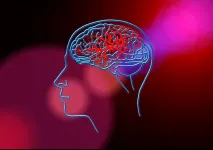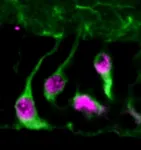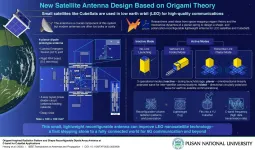Small is big: the need for a holistic approach to manage cerebral small vessel disease
Cerebral small vessel disease manifests as a wide range of symptoms, requiring a holistic approach for identification and intervention
2021-02-11
(Press-News.org) Cerebral small vessel disease (SVD) is characterized by damage to the blood vessels and parenchyma in the brain. It presents as a multitude of symptoms, which makes the diagnosis difficult. Matters are complicated further when SVD sets in along with other comorbidities with similar symptoms. Therefore, accurate diagnosis at an early stage of disease progression helps in defining better prognosis and management strategies for patients with cerebral SVD.
A team of researchers from the United Kingdom set out to review more than 10,000 studies on clinical diagnosis, risk factors, progression, and intervention in SVD patients. This review, now published in the Chinese Medical Journal, recommends a holistic, multidisciplinary assessment of individual needs in patients suspected to have SVD.
The literature review shows that cerebral SVD can present as various clinical symptoms, such as stroke, cognitive impairment, psychological issues, urinary problems, or gait- and balance-related manifestations. Because these symptoms are often also associated with other problems, Prof. Wardlaw, one of the reviewing researchers, states, "Clinical presentations are frequently multifactorial, particularly in older people, and therefore, a patient who presents with more than one of these symptoms has a higher chance of developing SVD."
The researchers also looked at some risk factors that might increase the likelihood of onset, progression, and severity of cerebral SVD in patients. They found that several risk factors like vascular health (condition of blood vessels and heart), lifestyle habits such as smoking and drinking, environment, and even cultural aspects can influence the development of SVD later in life. However, they also suggest that factors like socioeconomic background and biological sex of the patient need to be investigated further in order to understand whether they influence diagnosis or representation of symptoms.
The complexity of cerebral SVD is attributable not only to its wide range of symptoms and associated risk factors but also to the unavailability of a concrete therapeutic intervention for patients. Lifestyle changes like regular exercise, smoking cessation, and some kind of resistance training have shown positive effects in patients with SVD. Pharmacological intervention to control blood pressure and the lipid levels (amount of fat molecules) in the body has shown mixed effects. Prof. Wardlaw emphasizes, "Encouragingly, exercise and a healthy Mediterranean diet with folic acid and vitamin B12, combined with guideline-based vascular risk reduction through drugs, has been shown to slow cognitive decline in older people with cerebral SVD."
In addition to providing a detailed account of this disease, the researchers have also brought to light new, open questions in the research of this disease. Their literature review points to several gaps in our understanding of this disease, which can be investigated in the future. To that end, Prof. Wardlaw says, "We advocate for more clinical studies on psychological effects of this disease and trials to identify effective lifestyle and pharmaceutical interventions."
Trials on medications and modifiable as well as non-modifiable risk factors and a combination of these may help in a proper intervention. The researchers are hopeful that advanced preclinical, neuroimaging, and pathological research methods will help in finding an effective treatment for cerebral SVD. However, they emphasize that fully understanding a disease requires active patient involvement as well, and cerebral SVD is no different in this aspect. They suggest that it is a good idea for patients to be on top of the monitoring of their health and disease progression. To this end, technological interventions like mobile apps and virtual clinics, which can facilitate self-monitoring by patients and help doctors track their patient's health, can play a crucial role. This presents a fertile ground for innovators and interdisciplinary researchers to get involved in the management of cerebral SVD.
This review indicates that the "silent" symptoms of cerebral SVD can strike unsuspectingly and turn salient as the patient ages, affecting normal health and living. A holistic, multi-pronged approach is therefore essential to understand and deal with the progressive deterioration of neurological and overall health associated with cerebral SVD.
INFORMATION:
Reference
Titles of original papers: Clinical management of cerebral small vessel disease: a call for a holistic approach
Journal: Chinese Medical Journal
DOI: 10.1097/CM9.0000000000001177
[Attachments] See images for this press release:

ELSE PRESS RELEASES FROM THIS DATE:
2021-02-11
Experts have spent decades warning us about the rising rates of childhood obesity, which has become an epidemic among recent generations in many places around the world, including Spain. The transition from the traditional Mediterranean diet to the consumption of processed foods with low nutritional value is a key contributor, with child-targeted advertising also partly to blame. According to the Breakfast Food Advertisements in Mediterranean Countries: Products' Sugar Content in Adverts from 2015 to 2019 report produced by UOC Faculty of Information and Communication Sciences professor and researcher, Mireia Montaña, the majority of breakfast products ...
2021-02-11
In recent years, active, self-propelled particles have received growing interest amongst the scientific community. Examples of active particles and their systems are numerous and very diverse, ranging from bacterium films to flocks of birds or human crowds. These systems can demonstrate unusual behavior, which is challenging to understand or model.
To this end, large-scale models of active particles were being scrutinised by experts at Leicester, in order to understand basic principles underlying active particle dynamics and apply them in a scenario of an evacuation strategy for customers in crowded place. Unexpectedly, the 'super-particles' milling in a circular motion were stumbled upon ...
2021-02-11
There's a reason that ideas--even erroneous ones--catch fire on social media or in popular culture: groupthink.
New research co-authored by Berkeley Haas Asst. Prof. Douglas Guilbeault shows that large groups of people all tend to think alike, and also illustrates how easily people's opinions can be swayed by social media--even by artificial users known as bots.
In a series of experiments, published in the journal Nature Communications, Guilbeault and co-authors Damon Centola of the University of Pennsylvania and Andrea Baronchelli of City University London created an online game that asked numerous people to identify ...
2021-02-11
Just as beneficial microbes in the human gut can be affected by antibiotics, diet interventions and other disturbances, the microbiomes of other animals can also be upset. In a rare study published this week, Andrea Jani, a researcher with the University of Hawai'i at Mānoa School of Ocean and Earth Science and Technology (SOEST), determined the skin microbiome of an endangered frog was altered when the frogs were infected by a specific fungus, and it didn't recover to its initial state even when the frog was cured of the infection.
All animals host symbiotic microbes--many ...
2021-02-11
WASHINGTON--Chinese people are more likely to face high blood pressure and other health risks as a result of higher body mass index (BMI) and waist circumference than people from other racial and ethnic groups, according to a new study published in the Endocrine Society's END ...
2021-02-11
SINGAPORE, 10 February 2021 - Researchers studying an enzyme in fruit fly larvae have found that it plays an important role in waking up brain stem cells from their dormant 'quiescent' state, enabling them to proliferate and generate new neurons. Published in the journal EMBO Reports, the study by Duke-NUS Medical School, Singapore, could help clarify how some neurodevelopmental disorders such as autism and microcephaly occur.
Quiescent neural stem cells in the fruit fly larval brainPr-set7 is an enzyme involved in maintaining genome stability, DNA repair and cell cycle regulation, as well as ...
2021-02-11
Modern telecommunication systems rely on satellites to relay signals across the globe quickly and reliably, enabling users to send messages across the world in an instant, watch live television, or - more recently - hold conference calls with global partners right from the kitchen table!
Communications satellites use high-frequency radio waves to transmit data, with antennas acting as a two-way interface, converting electric current provided by the transmitter into radio waves, and vice versa when paired with a receiver. Antennas are therefore vital pieces of equipment, without which satellites and ground receivers would be practically useless. However, despite advances in modern satellite design and performance, antenna technology remains a limiting factor for ...
2021-02-11
With the advent of 5G communication technology and its integration with AI, we are looking at the dawn of a new era in which people, machines, objects, and devices are connected like never before. This smart era will be characterized by smart facilities and services such as self-driving cars, smart UAVs, and intelligent healthcare. This will be the aftermath of a technological revolution.
But the flip side of such technological revolution is that AI itself can be used to attack or threaten the security of 5G-enabled systems which, in turn, can greatly compromise their reliability. It is, therefore, imperative to investigate such potential security threats and explore countermeasures before a smart world is realized.
In a recent study published ...
2021-02-11
Researchers at the University of Virginia School of Medicine have shed light on what causes herpes simplex virus to flare up, explaining how stress, illness and even sunburn can trigger unwanted outbreaks.
The discovery could lead to new ways to prevent cold sores and herpes-related eye disease from reoccurring, the researchers report.
"Herpes simplex recurrence has long been associated with stress, fever and sunburn," said researcher Anna R. Cliffe, PhD, of UVA's Department of Microbiology, Immunology and Cancer Biology. "This study sheds light on how all these triggers can lead to herpes simplex-associated disease."
About Herpes Simplex ...
2021-02-11
Joe Biden is the new president of the United States, although half of the country's Republicans believe he stole the election. A lot of people believe conspiracy theories on the other side of the Atlantic. But they aren't only found there.
Conspiracy theories are not exclusive to people who storm the U.S. Capitol.
"Everyone believes at least one conspiracy theory," says Asbjørn Dyrendal, a professor in NTNU's Department of Philosophy and Religious Studies who specializes in conspiracy theories.
The more conspiracy theories you bring up, the more people answer yes to one of them.
That fact leads ...
LAST 30 PRESS RELEASES:
[Press-News.org] Small is big: the need for a holistic approach to manage cerebral small vessel disease
Cerebral small vessel disease manifests as a wide range of symptoms, requiring a holistic approach for identification and intervention





